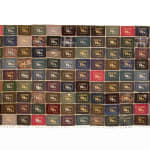-






Consuelo Jimenez Underwood American, b. 1949
C. Jane Run, 2005Hand pulled, silver and gold, silkscreened and pinned. on recycled clothing, safety pins, glass beads120 x 204 in
304.8 x 518.2 cmFurther images
Taken from California 1990s road signs found near the border, the image of a family fleeing has appeared several times in Jimenez Underwood’s work. It mimics the format of a...Taken from California 1990s road signs found near the border, the image of a family fleeing has appeared several times in Jimenez Underwood’s work. It mimics the format of a deer-crossing sign, a parallel which made the artist reflect: “they’re thinking of us as animals now.” During her childhood, her father was deported to Mexico on multiple occasions, forcing her and her family to smuggle him back over the border each time. This piece was made to honor all the anonymous souls who have not survived the crossing. But its title, which alludes to the Dick and Jane children’s series, calls attention to the little girl in particular, who the artist has also identified herself with in the past. The C, in fact, stands for Consuelo's name.
"When I found out that when a person is hit by a car at full speed, nothing recognizable is left, except small fragments of clothing, I felt the need to construct a memorial quilt of sorts, a large-scale textile created to honor the anonymous dead who died when crossing the freeway. Again, the need for the humble safety pin to step up to the plate! The beadwork reminds us that everyone needs even a little joy at the edge." Consuelo Jimenez Underwood.Exhibitions
Consuelo Jimenez Underwood: One Nation Underground, Ruiz-Healy Art, San Antonio, TX, 2022
Consuelo J. Underwood: Thread Songs from the Borderlands, 108 Contemporary, Tulsa, OK, 2018
Borderlines: The Art of Consuelo Jimenez Underwood, ArtRage Gallery, Syracuse, NY, 2015
Consuelo Jimenez Underwood: Welcome to Flower-Landia, Triton Museum of Art, Santa Clara, CA, 2013
Undocumented Borderlands, Conley Art Gallery, California State University, Fresno, Fresno, CA, 2011
Literature
Laura E. Perez and Ann Marie Leimer, eds., Consuelo Jimenez Underwood: Art, Weaving, Vision, Durham, North Carolina: Duke University Press, 2022, between pages 90-91 (illustrated)












